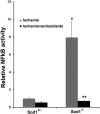Vascular cell-adhesion molecule-1 plays a central role in the proangiogenic effects of oxidative stress
- PMID: 21844360
- PMCID: PMC3167513
- DOI: 10.1073/pnas.1012859108
Vascular cell-adhesion molecule-1 plays a central role in the proangiogenic effects of oxidative stress
Abstract
Oxidative stress exacerbates neovascularization (NV) in many disease processes. In this study we investigated the mechanism of that effect. Mice deficient in superoxide dismutase 1 (Sod1(-/-) mice) have increased oxidative stress and show severe ocular NV that is reduced to baseline by antioxidants. Compared with wild-type mice with ischemic retinopathy, Sod1(-/-) mice with ischemic retinopathy had increased expression of several NF-κB-responsive genes, but expression of vascular cell-adhesion molecule-1 (Vcam1) was particularly high. Intraocular injection of anti-VCAM-1 antibody eliminated the excessive ischemia-induced retinal NV. Elements that contributed to oxidative stress-induced worsening of retinal NV that were abrogated by blockade of VCAM-1 included increases in leukostasis, influx of bone marrow-derived cells, and capillary closure. Compared with ischemia alone, ischemia plus oxidative stress resulted in increased expression of several HIF-1-responsive genes caused in part by VCAM-1-induced worsening of nonperfusion and, hence, ischemia, because anti-VCAM-1 significantly reduced the increased expression of all but one of the genes. These data explain why oxidative stress worsens ischemia-induced retinal NV and may be relevant to other neovascular diseases in which oxidative stress has been implicated. The data also suggest that antagonism of VCAM-1 provides a potential therapy to combat worsening of neovascular diseases by oxidative stress.
Conflict of interest statement
The authors declare no conflict of interest.
Figures




Similar articles
-
Oxidative stress promotes ocular neovascularization.J Cell Physiol. 2009 Jun;219(3):544-52. doi: 10.1002/jcp.21698. J Cell Physiol. 2009. PMID: 19142872 Free PMC article.
-
TNF-alpha is critical for ischemia-induced leukostasis, but not retinal neovascularization nor VEGF-induced leakage.J Neuroimmunol. 2007 Jan;182(1-2):73-9. doi: 10.1016/j.jneuroim.2006.09.015. Epub 2006 Nov 14. J Neuroimmunol. 2007. PMID: 17107717 Free PMC article.
-
The HIF-1 antagonist acriflavine: visualization in retina and suppression of ocular neovascularization.J Mol Med (Berl). 2017 Apr;95(4):417-429. doi: 10.1007/s00109-016-1498-9. Epub 2016 Dec 21. J Mol Med (Berl). 2017. PMID: 28004126 Free PMC article.
-
Molecular pathogenesis of retinal and choroidal vascular diseases.Prog Retin Eye Res. 2015 Nov;49:67-81. doi: 10.1016/j.preteyeres.2015.06.002. Epub 2015 Jun 23. Prog Retin Eye Res. 2015. PMID: 26113211 Free PMC article. Review.
-
[Aging and retinal vascular diseases].Nippon Ganka Gakkai Zasshi. 2007 Mar;111(3):207-30; discussion 231. Nippon Ganka Gakkai Zasshi. 2007. PMID: 17402563 Review. Japanese.
Cited by
-
The effect of nicotinamide adenine dinucleotide phosphate oxidase 4 on migration and invasion of fibroblast-like synoviocytes in rheumatoid arthritis.Arthritis Res Ther. 2020 May 15;22(1):116. doi: 10.1186/s13075-020-02204-0. Arthritis Res Ther. 2020. PMID: 32414400 Free PMC article.
-
Targeting VE-PTP activates TIE2 and stabilizes the ocular vasculature.J Clin Invest. 2014 Oct;124(10):4564-76. doi: 10.1172/JCI74527. Epub 2014 Sep 2. J Clin Invest. 2014. PMID: 25180601 Free PMC article.
-
S-glutathionylation, friend or foe in cardiovascular health and disease.Redox Biol. 2020 Oct;37:101693. doi: 10.1016/j.redox.2020.101693. Epub 2020 Aug 22. Redox Biol. 2020. PMID: 32912836 Free PMC article. Review.
-
Betalain exerts a protective effect against glaucoma is majorly through the association of inflammatory cytokines.AMB Express. 2020 Jul 14;10(1):125. doi: 10.1186/s13568-020-01062-y. AMB Express. 2020. PMID: 32666339 Free PMC article.
-
Genetic modification of corneal neovascularization in Dstn (corn1) mice.Mamm Genome. 2013 Oct;24(9-10):349-57. doi: 10.1007/s00335-013-9468-9. Epub 2013 Aug 9. Mamm Genome. 2013. PMID: 23929036 Free PMC article.
References
-
- Semenza GL. HIF-1: Mediator of physiological and pathophysiological responses to hypoxia. J Appl Physiol. 2000;88:1474–1480. - PubMed
-
- Ozaki H, et al. Hypoxia inducible factor-1α is increased in ischemic retina: Temporal and spatial correlation with VEGF expression. Invest Ophthalmol Vis Sci. 1999;40:182–189. - PubMed
-
- Kelly BD, et al. Cell type-specific regulation of angiogenic growth factor gene expression and induction of angiogenesis in nonischemic tissue by a constitutively active form of hypoxia-inducible factor 1. Circ Res. 2003;93:1074–1081. - PubMed
-
- Vinores SA, et al. Implication of the hypoxia response element of the Vegf promoter in mouse models of retinal and choroidal neovascularization, but not retinal vascular development. J Cell Physiol. 2006;206:749–758. - PubMed
Publication types
MeSH terms
Substances
Grants and funding
LinkOut - more resources
Full Text Sources
Other Literature Sources
Molecular Biology Databases
Miscellaneous

